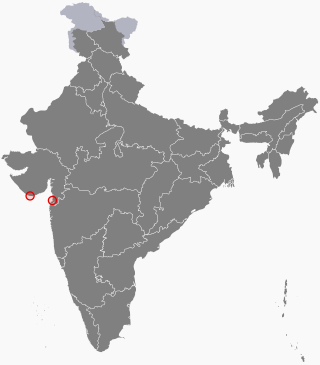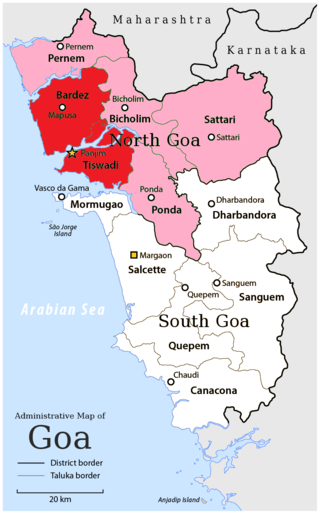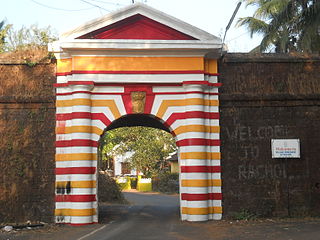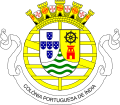
The State Emblem of India is the national emblem of the Republic of India and is used by the union government, many state governments, and other government agencies. The emblem is an adaptation of the Lion Capital of Ashoka, an ancient sculpture dating back to 280 BCE during the Maurya Empire. The statue is a three dimensional emblem showing four lions. It became the emblem of the Dominion of India in December 1947, and later the emblem of the Republic of India. The State Emblem of India is an official seal of the Government of India. It is used as the national emblem of India and appears on official documents, currency and passports.

The national emblem of Angola is the national emblem of Angola that reflects the recent past of the new nation. There is heavy Marxist imagery found on the device, expanded from what is found on the national flag.

Daman and Diu was a union territory in northwestern India. With an area of 112 km2 (43 sq mi), it was the smallest administrative subdivision of India on the mainland. The territory comprised two districts, Daman and Diu island, geographically separated by the Gulf of Khambat. The state of Gujarat and the Arabian Sea bordered the territory. A Portuguese colony since the 1500s, the territories were taken by India with the Annexation of Goa in 1961. Daman and Diu were administered as part of the union territory of Goa, Daman and Diu between 1961 and 1987. After the Goa Opinion Poll, they became a separate union territory. In 2019, legislation was passed to merge the union territory of Daman and Diu with its neighbouring union territory, Dadra and Nagar Haveli, to form the new union territory of Dadra and Nagar Haveli and Daman and Diu with effect from 26 January 2020.

The State of India, also referred as the Portuguese State of India or simply Portuguese India, was a state of the Portuguese Empire founded six years after the discovery of a sea route to the Indian subcontinent by Vasco da Gama, a subject of the Kingdom of Portugal. The capital of Portuguese India served as the governing centre of a string of military forts and trading posts scattered all over the Indian Ocean.

North Goa district is one of the two districts that constitutes the state of Goa, India. The district has an area of 1,736 square kilometres, and is bounded by Kolhapur and Sindhudurg districts of Maharashtra state to the north and by Belgavi district of Karnataka to the east, by South Goa district to the south, and by the Arabian Sea to the west.
The Comunidades of Goa are a form of land association developed in Goa, India, where land-ownership is collectively held, but controlled by the male descendants of those who claimed to be the founders of the village, who in turn mostly belonged to upper caste groups. Documented by the Portuguese as of 1526, it was the predominant form of landholding in Goa prior to 1961. In form, it is similar to many other rural agricultural peoples' form of landholding, such as that of pre-Spanish Bolivia and the Puebloan peoples now in the Southwestern United States, identified by Karl Marx as the dualism of rural communities: the existence of collective land ownership together with private production on the land.

Goa, Daman and Diu was a union territory of the Republic of India established in 1961 following the annexation of Portuguese India, with Maj Gen K P Candeth as its first Military Governor. The Goa portion of the territory was granted full statehood within the Indian union on 30 May 1987, Daman and Diu remained a separate territory until December 2019, when it was merged with Dadra and Nagar Haveli and is today the territory of Dadra and Nagar Haveli and Daman and Diu.

The national emblem of East Timor is one of the national symbols of East Timor.
Daman district, is one of four districts of the Indian union territory of Dadra and Nagar Haveli and Daman and Diu on the west coast of India. It is surrounded by the Valsad district of the Gujarat state to the north, east and south and the Arabian Sea to the west. The district has an area of 72 square kilometres (28 sq mi), and a population of 191,173 as of the 2011 census, an increase of 69.256% from the 2001 Census. The district headquarters is Daman. The previous territorial headquarters were in Panjim when it was jointly administered as Goa, Daman and Diu until the time of the Konkani language agitation.

Diu district is one of the three districts of the union territory of Dadra and Nagar Haveli and Daman and Diu of India. The district is made up of Diu Island and two small enclaves in the State of Gujarat. The district headquarters are at Diu Town. It is the ninth least populous district in the country.

The Annexation of Goa was the process in which the Republic of India annexed the State of India, the then Portuguese Indian territories of Goa, Daman and Diu, starting with the armed action carried out by the Indian Armed Forces in December 1961. In India, this action is referred to as the "Liberation of Goa". In Portugal, it is referred to as the "Invasion of Goa". Jawaharlal Nehru had hoped that the popular movement in Goa and the pressure of world public opinion would force the Portuguese Goan authorities to grant it independence, but without success; consequently, Krishna Menon suggested taking Goa by force.

The Emblem of Kerala used by Government of Kerala, to represent the state in all its official correspondences. The emblem portrays two elephants guarding the state emblem of India and the Shankh of Sri Padmanabhaswamy according to the history of Kerala.
Transportes Aéreos da Índia Portuguesa or TAIP was an airline which operated from Portuguese India from 1955 to 1961. During this period, it functioned as the state airline of Portuguese India, which comprised Goa, Daman and Diu.

The Twelfth Amendment of the Constitution of India, officially known as The Constitution Act, 1962, incorporated Goa, Daman and Diu as the eighth Union territory of India, by amending the First Schedule to the Constitution. India acquired control of Goa, Daman and Diu from Portugal in December 1961. The amendment also amended clause (1) of article 240 of the Constitution to include therein these territories in order to enable the President to "make regulations for the peace, progress and good government of the territory".

The Rachol Fort is a historical Portuguese era fort located in the village of Rachol, Salcette concelho, in the state of Goa on the west coast of India.

Dadra and Nagar Haveli and Daman and Diu is a union territory in India. The territory was constituted through the merger of the former territories of Dadra and Nagar Haveli and Daman and Diu. Plans for the proposed merger were announced by the Government of India in July 2019; the necessary legislation was passed in the Parliament of India in December 2019 and came into effect on 26 January 2020. The territory is made up of four separate geographical entities: Dadra, Nagar Haveli, Daman, and the island of Diu. All four areas were formerly part of Portuguese India, and had a joint capital at Panjim, Goa along with Goa. They came under Indian rule in the mid-20th century after the Annexation of Goa and of the Free Dadra and Nagar Haveli. Goa, Daman and Diu were jointly administered until 1987, when Goa was granted statehood after the Konkani language agitation. The current capital is Daman and Silvassa is the largest city.
The first elections to the Goa, Daman & Diu Legislative Assembly were held in December 1963, to elect members of the 30 constituencies, in the Union territory of Goa, Daman and Diu, India.



















